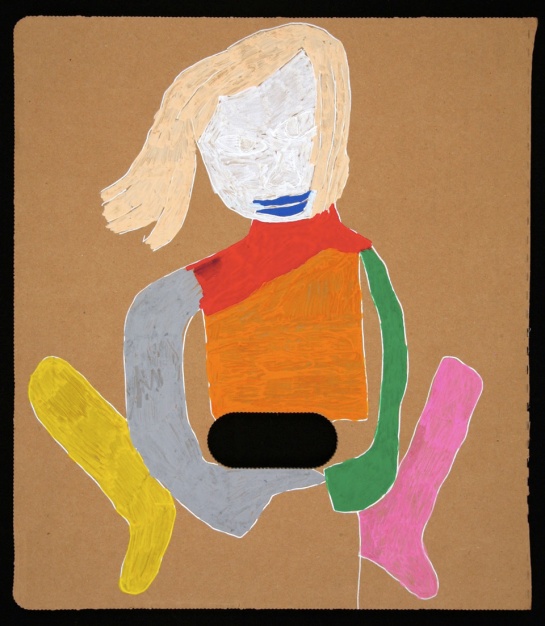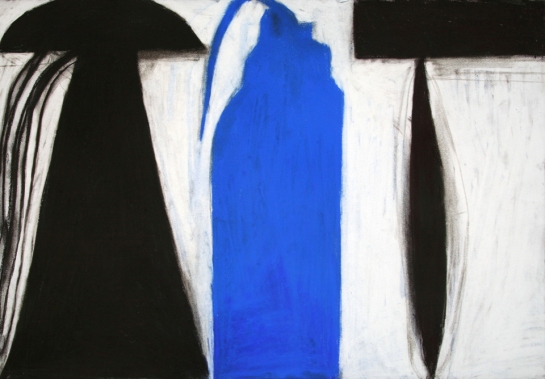The Outsider Renaissance
Art Brut: is visual creation at its purest – a spontaneous psychic flow from brain to surface
Outsider Art: has been used increasingly loosely and can often now refer to any artist who is untrained or with disabilities or suffering social exclusion, whatever the nature of their work
source: Raw Vision Definitions
Outsider Art, or the more aptly-named Art Brut (raw art), has always been the genre which fascinates me the most. Its methods and theories are born of the same basis as my own values regarding art production and criticism. Its outputs never fail to fascinate me, conveying in often cryptic form inherent emotions and opinions through a direct outpouring of expression. The genre seems to be having something of a renaissance recently, with the intense Koestler Trust ‘prison art’ shows at the Southbank, the very in-vogue Hayward Gallery hosting the Museum of Everything at their current Alternative Guide to the Universe exhibition and of course Souzou; Outsider Art in Japan, which finished at the Wellcome Collection on Sunday. Outsider Art hasn’t been this fashionable since Basquiat in the 80s. Good. Lovely. But although almost every facet of it strikes a chord with me, I’ve also always been a tad dubious about the label and its use, or misuse, in the separation of art and artists.
Even in an exhibition about art from a culture I know very little about, I can see stylistic riffs running throughout many of the works which would probably help to classify them as ‘outsider’. One such example is that of smallness and intricate detail which can often, but not always, be linked to introversion and a lack of confidence. I can use the case of a student at Artbox as an example of my experience of this: 3 years ago Chris, on encouragement to put material to paper, would almost always begin a detailed and creative scene in the furthest corner of the paper, using up often only about 4cm2 of an A4 page. It was 2 years before we realised the significance of that technique, as Chris gradually opened himself up to us and to his own artistic expression; he can currently be found sweeping brushstrokes across A1 sheets blindfolded whilst listening to music. Transformation. Many people don’t emerge from the cocoon in the way Chris did; for some, the lack of confidence and fear of opening up continues to manifest through their works. Norimitsu Kokubo’s intensely detailed city scenes, Yumiko Kawai’s intricate embroidery and Shota Katsube’s army of tiny twist-tie figures are all examples of this style. A preoccupation with size also features in other works such as ‘Mother’ by Takako Shibata; a poignantly ever increasing and subsequently disappearing-off-the-page portrait of the artist’s absent mother.
Outsider Art is sometimes defined as being produced by those who create spontaneously, without the influence of the establishment and art culture and without a commission. This is almost only ever partly true. Prison artists for example have often been very much informed by culture and are aware of the established market. But you can see the general idea ie. they’re not fresh meat straight out of St Martin’s, sitting in a South London studio tearing their hair out in a dramatically melancholic search for the inspiration to win this year’s Turner Prize. Outsider Artists are usually those who have come to the practice through somewhat ‘anti-social’ means; they are often incarcerated in a prison or mental health institute, but by no means always. Art therapy would fall under the ‘Outsider’ classification, but in art therapy the artists can be from any walk of life and in any situation, eg.divorce, depression, rather than necessarily prison-based or mentally ill. So if the scope can include Art Therapy and definition is therefore not reliant on any specific life situations, it follows that inclusion in the Outsider Art category must be more focused on the means of production.
Art Brut, Outsider Art, Souzou – Raw Art. Art by means of immediate and direct expression, an outpouring, art from the soul. I see what the categorists are trying to do through this definition, but although part of me agrees, another part doesn’t. In some cases it is possible to distinguish fairly easily between types of people, situation and production style, eg. the difference in work and means between a graduate art student trying to pay the bills and a lifer in prison extracting some cathartic relief from art production, but what about in an instance such as between Paul Gaugin and Vincent van Gogh? One a manically depressed recluse who cut off his own ear in a fit of rage (allegedly), the other considered to be, although perhaps not entirely straight-laced, a fairly well-balanced traditional artistè. Despite fitting most of the criteria for an ‘Outsider Artist’ van Gogh is not generally included in this grouping and was also producing art for recognition, for money, as was Basquiat in the 80s even though he was classed as Outsider. In parallel with this, many artists in the Souzou exhibition contradict the classification by creating works influenced by cultural tradition or are known for their work and have sold pieces. Through social and charitable initiatives such as Artbox or Centerpieces (I’m lucky to own a fabulous ‘outsider art’ piece by Rich Zyzanski) this is actually more and more common, and not at all a bad thing. Does this then diminish from their ability to produce a direct expressive outpouring through artistic production? I don’t think so. Surely these rigid boundaries of definition cannot meaningfully apply to all artists without diminishing their individuality? Our very human obsession with labels and boxes leads us to the point where we ignore the essential grey area, the blurring of the boundaries and as such, the system files in error. Is it about time to de-compartmentalise art or should we step up the factioning to create a more meticulous framework? Either way by its very nature one size does not fit all when it comes to Art Brut.










I have difficulty with the labeling of an artist or his/her art as “outsider”. Still, given all the classifications that the art world puts on art and artists, I reluctantly accept that label for art and artists who have had no formal art training. I think Basquiat never studied art. Add that fact to his street art and I think that the label applies. But without those two descriptions, I would not accept that label for him or for myself — I have no art training, formal or informal. I teach myself how to paint, how to get what I want from the materials I work with. And yes, like all artists, I am informed by what I see around me.
Thanks for the comment, and for the mention on your post! I feel that with each person the boundaries can blur, there are so many factors that would be used to define an ‘outsider artist’ that most of them will never fit exactly into that category. Someone like Gaugin had no formal training but was linked with the Impressionists so does not get the label. Others, such as art therapists and their clients, have had lots of formal training and are often established artists, yet their work is classed as ‘outsider’ as it’s in the territory of health rather than the art establishment. It’s all so tenuous I find the categorisation too unreliable! Also, the idea that ‘outsider’ art is a direct expression of the soul – what art isn’t!? Even commissioned, commercial art carries with it a piece of the person who created it. That description cannot tie to outsider artists alone.
I totally agree with all the points you made. And that last part about commissioned, commercial art? Remember the case of Diego Rivera and the Rockefeller mural? He was commissioned to paint one thing and he turned it into an accusation, a condemnation of capitalism and his patron. So yes, even with commissions comes a piece of the person and his/her soul. Although, with Andy Warhol, I wonder if any of that is true?
Yes definitely. I’m don’t think it’s even possible to create art without expression, even copying, or creating commercial art of any kind. Your own style will be in there somewhere, or if not, then your feeling. No-one can feel nothing, and what you’re feeling whilst creating is in itself expression, whether it’s hatred or enjoyment or anything else. Warhol had a passion for aesthetics and the intellectual conceptualism of commercialism (which he then parodied), so that passion certainly came through in what he created.
Pingback: The Outsider Renaissance | Bay Area Adventures